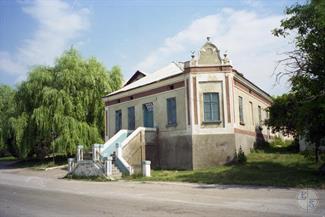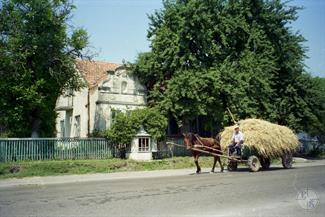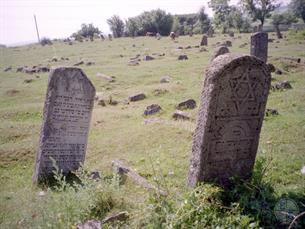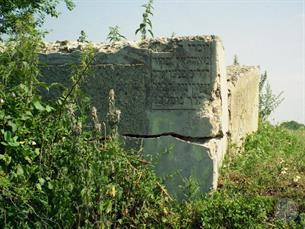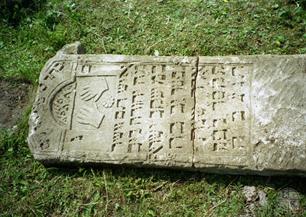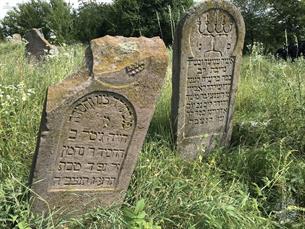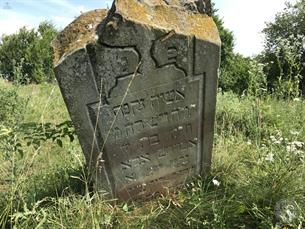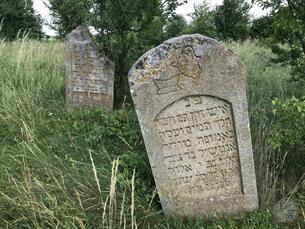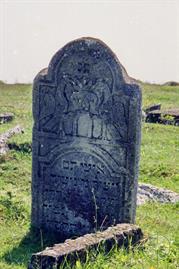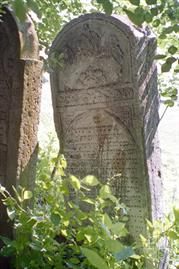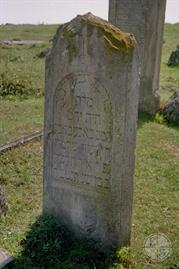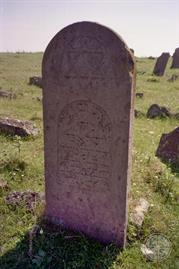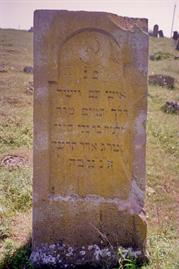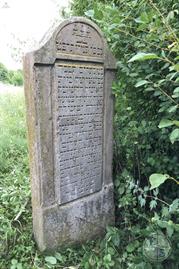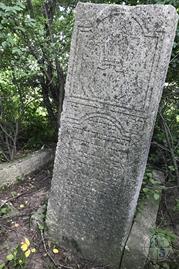Ozeryany
Borshchiv district, Ternopil region
Sources:
- Pinkas Hakehillot Polin: Encyclopedia of Jewish Communities, Poland, Volume II, pages 288-290, published by Yad Vashem, Jerusalem. Translated by Ruth Wachspress, JewishGen, Inc.
Photo:
- Benjamin Lukin, Center for Jewish Art, 1997. New Jewish cemetery in Ozeriany; Ozeriany (Jezierzany), Ukraine
- Hryhoriy Arshynov, European Jewish Cemeteries Initiative, 2019. Ozeryany Old Jewish Cemetery
- Pinkas Hakehillot Polin: Encyclopedia of Jewish Communities, Poland, Volume II, pages 288-290, published by Yad Vashem, Jerusalem. Translated by Ruth Wachspress, JewishGen, Inc.
Photo:
- Benjamin Lukin, Center for Jewish Art, 1997. New Jewish cemetery in Ozeriany; Ozeriany (Jezierzany), Ukraine
- Hryhoriy Arshynov, European Jewish Cemeteries Initiative, 2019. Ozeryany Old Jewish Cemetery
As long ago as the 16th and 17th century, there was indication from taxpayer lists that there was a Jewish presence in the area of Jezierzany (ukr. Ozeryany, Озеряни). From 1717 to 1764, during the winter months, a unit of infantry was positioned in the town and it was assumed that the fear of pogroms deterred Jews from settling in the town itself.
Until 1765 Jezierzany was part of the royal estate. That year it was leased to a Polish dignitary. After the division of Poland in 1772 and annexation by Austria, Jezierzany was sold again to a royal dignitary and finally was transferred to a Prince Leon Safaya.
The Jewish settlement of the town started in the 19th century. In 1902 a railroad was built nearby and the workers who were brought in from Western Galicia to lay the railroad tracks attempted to start a pogrom. They were forced to retreat by an organized Jewish defense group (Haganah). At the end of the 19th century they organized a trade union, calling it "The Hand of the Workers" and in 1905, established The Merchant and Craftsmen Bank which was in operation until the beginning of the first world war. In 1912, a fire destroyed many of the houses in the town center leaving 30 Jewish families without any shelter. The community came together to help those in need. They also organized and built their own "shteebles" (small synagogues that followed a particular Rabbi's teachings).
From 1890 to the first world war, the Jews were the majority of the inhabitants of the locality. The non-Jews lived in the suburbs around the town and were predominantly farmers. In August of 1914, the Russians conquered the town and remained until 1917. During this period, the Jews of Jezierzany had an easier time compared to the Jews in other cities but due to the needs of their brethren in the surrounding towns as well as the typhoid epidemic of 1915-1916, their economy suffered. Jezierzany established a Committee of Assistance and together with a similar organization in the city of Kiev, they were able to distribute food, clothing and even money to the needy.
Until 1765 Jezierzany was part of the royal estate. That year it was leased to a Polish dignitary. After the division of Poland in 1772 and annexation by Austria, Jezierzany was sold again to a royal dignitary and finally was transferred to a Prince Leon Safaya.
The Jewish settlement of the town started in the 19th century. In 1902 a railroad was built nearby and the workers who were brought in from Western Galicia to lay the railroad tracks attempted to start a pogrom. They were forced to retreat by an organized Jewish defense group (Haganah). At the end of the 19th century they organized a trade union, calling it "The Hand of the Workers" and in 1905, established The Merchant and Craftsmen Bank which was in operation until the beginning of the first world war. In 1912, a fire destroyed many of the houses in the town center leaving 30 Jewish families without any shelter. The community came together to help those in need. They also organized and built their own "shteebles" (small synagogues that followed a particular Rabbi's teachings).
From 1890 to the first world war, the Jews were the majority of the inhabitants of the locality. The non-Jews lived in the suburbs around the town and were predominantly farmers. In August of 1914, the Russians conquered the town and remained until 1917. During this period, the Jews of Jezierzany had an easier time compared to the Jews in other cities but due to the needs of their brethren in the surrounding towns as well as the typhoid epidemic of 1915-1916, their economy suffered. Jezierzany established a Committee of Assistance and together with a similar organization in the city of Kiev, they were able to distribute food, clothing and even money to the needy.
During the Russian retreat in 1917, the soldiers carried out pogroms against the Jews, killing, raping and destroying property. With the disintegration of the Austro-Hungarian regime at the end of 1918, a Western Ukrainian government was established. Twice in 1920, outlaw gangs invaded Jezierzany, killing, raping, and again causing much destruction. Some were caught and arrested but held only for a short time. In the fall of 1920, the Poles returned to Jezierzany and governed until September of 1939.
In the last decade of the 19th century and especially the 20th century, there was a significant migration of local Jewry overseas. In 1897, there was already in America, a sizeable contingent of immigrants from Jezierzany - enough to establish their own Benevolent Society.
In 1924, the town was forced by the Government to merge with another village of over 1000 inhabitants. This was done to eliminate the Jewish majority in Jezierzany. Most of the Jews were merchants, small businessmen, tailors, furriers, dressmakers and craftspeople, who made simple furniture, as well as small farmers. Much of the business took place in the local markets. The market in Jezierzany, was well known because it was where horses and cattle were sold. The primary purchaser of the horses was the Austrian Army and the customers for the other products were the farmers in the surrounding countryside.
The economic conditions in Jezierzany worsened between the two World Wars. The taxes were increased and, in 1925, with the Austrian government no longer needing horses for its Army, the market in Jezierzany was closed. As a result, the rest of the economy suffered. The Poles opened farm cooperatives and the Jews could not compete.
In 1930, the non-Jewish population was told by the Church not to do business with the Jews. This caused an upsurge of need among the Jews. The situation was so bad that the local Jewish organizations were unable to handle the problem. The wealthier people in the area opened a kitchen to feed and clothe the orphaned and poor children as well as to give them books. They helped residents to rebuild their houses and arranged for doctors to visit the sick. They even helped brides with their dowry. There was also a group called "Help for the Poor" which provided wood for heating and flour for bread. They also received money from their "landtsmen" in the U.S. as well as aid from the American Jewish Joint Distribution Committee.
In 1927, two former residents of the village, who had emigrated, returned and brought with them a gift of money. Most of this money was to be used for the schooling of the children in the Torah. In 1927, another organization called "The Committee of the Righteous" was started. In 1933 and 1934 it had disbursed more than 24,000 Zlotys to the poor.
Jewish religious life in Jezierzany at the end of the 18th and the beginning of the 19th century centered aound a large wooden Synagogue surrounded by the "Shteebles".
Later in the 19th century, a yeshiva was built. A Hasidic synagogue was built when a woman by the name of Molly donated the funds needed. The town was well known for the many rabbis who lived there over the centuries, the most famous of whom was Rabbi Shimon Halevi Haler who died in 1839.
From the end of the 19th century until the 1930's, the head of the community was a man named Shmuel Pohorils, a Zionist.. After he emigrated to Eretz Yisrael, he was replaced by Mendel Meyerberger. He was also the head of the Judenraut (The Jewish Council). During the time that Jezierzany was part of the Austro-Hungarian Empire, the Jews flourished. But beginning in 19l7 and until the 2nd World War, they were no longer allowed to take part in the government.
By the end of the 19th and beginning of the 20th century, the children of the town began to receive a secular education. As a result, they left for the larger cities where they were able to get more advanced education. They became writers, poets, newspaper editors and publishers. One of the most famous was M. S.Tenenblatt, the publisher of the Tagenblatt in Lvov.
The first Zionist organization in Jezierzany, Agudath Zion, was started in the beginning of the 1900's. It had a library and taught the Hebrew language and literature.
In 1918 and 1919, two more Zionist organizations were established in the town, one was the Labor Zionist and the other was called Hope of Zion. The Hope of Zion had a theater group and in 1923 they built a small farm (kibbutz) to train for their emigration to Palestine.
In 1928, another kibbutz called Gordonia, was established and this was the base for the Revisionist movement (Betar).
By 1931, there were 300 people who belonged to four different Zionist organizations in this one small town.
Between the two World Wars, these Zionist organizations ran a secular Hebrew Day School with drama and music classes and a library that contained more than 2,000 books, named for the famous poet and writer, I. L. Peretz, as well as a reading hall where lectures where given.
In the last decade of the 19th century and especially the 20th century, there was a significant migration of local Jewry overseas. In 1897, there was already in America, a sizeable contingent of immigrants from Jezierzany - enough to establish their own Benevolent Society.
In 1924, the town was forced by the Government to merge with another village of over 1000 inhabitants. This was done to eliminate the Jewish majority in Jezierzany. Most of the Jews were merchants, small businessmen, tailors, furriers, dressmakers and craftspeople, who made simple furniture, as well as small farmers. Much of the business took place in the local markets. The market in Jezierzany, was well known because it was where horses and cattle were sold. The primary purchaser of the horses was the Austrian Army and the customers for the other products were the farmers in the surrounding countryside.
The economic conditions in Jezierzany worsened between the two World Wars. The taxes were increased and, in 1925, with the Austrian government no longer needing horses for its Army, the market in Jezierzany was closed. As a result, the rest of the economy suffered. The Poles opened farm cooperatives and the Jews could not compete.
In 1930, the non-Jewish population was told by the Church not to do business with the Jews. This caused an upsurge of need among the Jews. The situation was so bad that the local Jewish organizations were unable to handle the problem. The wealthier people in the area opened a kitchen to feed and clothe the orphaned and poor children as well as to give them books. They helped residents to rebuild their houses and arranged for doctors to visit the sick. They even helped brides with their dowry. There was also a group called "Help for the Poor" which provided wood for heating and flour for bread. They also received money from their "landtsmen" in the U.S. as well as aid from the American Jewish Joint Distribution Committee.
In 1927, two former residents of the village, who had emigrated, returned and brought with them a gift of money. Most of this money was to be used for the schooling of the children in the Torah. In 1927, another organization called "The Committee of the Righteous" was started. In 1933 and 1934 it had disbursed more than 24,000 Zlotys to the poor.
Jewish religious life in Jezierzany at the end of the 18th and the beginning of the 19th century centered aound a large wooden Synagogue surrounded by the "Shteebles".
Later in the 19th century, a yeshiva was built. A Hasidic synagogue was built when a woman by the name of Molly donated the funds needed. The town was well known for the many rabbis who lived there over the centuries, the most famous of whom was Rabbi Shimon Halevi Haler who died in 1839.
From the end of the 19th century until the 1930's, the head of the community was a man named Shmuel Pohorils, a Zionist.. After he emigrated to Eretz Yisrael, he was replaced by Mendel Meyerberger. He was also the head of the Judenraut (The Jewish Council). During the time that Jezierzany was part of the Austro-Hungarian Empire, the Jews flourished. But beginning in 19l7 and until the 2nd World War, they were no longer allowed to take part in the government.
By the end of the 19th and beginning of the 20th century, the children of the town began to receive a secular education. As a result, they left for the larger cities where they were able to get more advanced education. They became writers, poets, newspaper editors and publishers. One of the most famous was M. S.Tenenblatt, the publisher of the Tagenblatt in Lvov.
The first Zionist organization in Jezierzany, Agudath Zion, was started in the beginning of the 1900's. It had a library and taught the Hebrew language and literature.
In 1918 and 1919, two more Zionist organizations were established in the town, one was the Labor Zionist and the other was called Hope of Zion. The Hope of Zion had a theater group and in 1923 they built a small farm (kibbutz) to train for their emigration to Palestine.
In 1928, another kibbutz called Gordonia, was established and this was the base for the Revisionist movement (Betar).
By 1931, there were 300 people who belonged to four different Zionist organizations in this one small town.
Between the two World Wars, these Zionist organizations ran a secular Hebrew Day School with drama and music classes and a library that contained more than 2,000 books, named for the famous poet and writer, I. L. Peretz, as well as a reading hall where lectures where given.
In Sept. 1939, when the second World War started, Jezierzany, because of its closeness to the Rumanian border, became an important crossing place for refugees escaping the German Army. Among the refugees were Jews who received help from the Jewish community in Jezierzany and some of them decided to stay in the village. On Sept. 17, 1939. the Russian army came into the village and a lot of the middle class Jewish storekeepers were afraid of the communists. After awhile some of the Jewish stores closed and those that remained open had very little merchandise and taxes became prohibitive. Some of the tailors, dressmakers and shoemakers continued to work privately until the Russians created cooperatives and unless the Jews joined they could no longer work.
Jewish political and Zionist life in the village came to a standstill once the Russians arrived, but a few of the young leftist Jews in the community became part of the new city government. Some of the refugees from western Poland who had escaped to Jezierzany were deported East to Russia and when the Germans invaded Russia on June 22, 1941, a sizeable amount of Jewish young men were forced into the Russian army. However by the end of June, when the Russians left the town, only a few of the remaining Jews went with them.
Jewish political and Zionist life in the village came to a standstill once the Russians arrived, but a few of the young leftist Jews in the community became part of the new city government. Some of the refugees from western Poland who had escaped to Jezierzany were deported East to Russia and when the Germans invaded Russia on June 22, 1941, a sizeable amount of Jewish young men were forced into the Russian army. However by the end of June, when the Russians left the town, only a few of the remaining Jews went with them.
On July 8, 1941, an Hungarian regiment came into Jezierzany. The town government was then in the hands of the Nationalistic Ukrainians. In the middle of July, the Ukrainian police took a large number of Jewish men into the forest of Lupnick to kill them but the Hungarian officers stopped them. At the same time, other Jews in the surrounding towns were not so fortunate, and were murdered. The remnants of these communities escaped to Jezierzany and found help from the Jewish community that was left. During the months of July and August 1941, Jezierzany became a stopover for many of the Jews fleeing eastward over the Carpathion Mts. and some of them stayed for awhile because the Jewish community did their best to feed and clothe them before sending them on their way to Borszczow (the main city of the district).
At the beginning of their occupation of Jezierzany, the Hungarians took conscripted Jews to labor camps to help build bridges and roads that were desperately needed in the area. Using the excuse of looking for communists, the Ukrainian police would search and rob the Jewish homes and arrest them on suspicion of being communists. They set up prisons in the basements of government buildings where many of those arrested were tortured and even killed.
As one can imagine, the Jewish community in Jezierzany had to deal with a lot of urgent problems. They needed someone to deal with both the Hungarian army and the Ukrainian city government, the problem of the labor camps, and even more important those people who were arrested as communists as well as to continue to help the all the refugees coming through the town and their own inhabitants. The organization that was trying to do all this was established in Sept.1939.
At the beginning of their occupation of Jezierzany, the Hungarians took conscripted Jews to labor camps to help build bridges and roads that were desperately needed in the area. Using the excuse of looking for communists, the Ukrainian police would search and rob the Jewish homes and arrest them on suspicion of being communists. They set up prisons in the basements of government buildings where many of those arrested were tortured and even killed.
As one can imagine, the Jewish community in Jezierzany had to deal with a lot of urgent problems. They needed someone to deal with both the Hungarian army and the Ukrainian city government, the problem of the labor camps, and even more important those people who were arrested as communists as well as to continue to help the all the refugees coming through the town and their own inhabitants. The organization that was trying to do all this was established in Sept.1939.
In Sept 1941, the Germans took over the government in Jezierzany and they started the Judenrat (the Jewish police). Some of the people from the Jewish community organiztions had to join and among them was Mendel Meyerberger, who years earlier had been Mayor of the town. It is said that Meyerberger and most of the Jews who had to work for the Judenrat tried very hard to lessen the suffering of the community. In October of 1941, the Germans established the Jewish ghetto and no one was allowed to leave for any reason. The punishment for leaving was very severe but the hunger forced them to try to escape to neighboring villages to try to bring back food. The community was asked to supply 150 young people to go to the labor camps but the Judenrat went to the Germans and was able to get them to reduce the number to 100. The Judenrat later established a new committee to help people who were sent to concentration camps by sending them food and keeping them in touch with family who remained in the village.
In the spring of 1942 more groups of young people were taken to the workcamps and the Judentrat would help them with food and clothing and sometimes even bribing the guards to release some of them but the workcamps were always able to refill their ranks from the surrounding Jewish communities. Most of the people in these camps died from either the hard work, disease and even torture.
In the summer of 1943, the camps were closed and those left killed.
In the winter of 1941-42, the Jews of Jezierzany were forced to give the Germans all their silver, gold and furs and had to pay them a heavy tax every few months. On the former Zionist kibbutzim, the Germans planted a product which they hoped to make into synthetic rubber In the summer of 1942 about 70 Jewish young women worked on the farm.
That same summer, the Germans took about 200 Jews from the smaller villages surrounding Jezierzany and forced them into the Jezierzany Ghetto. In the early morning of September 26, 1942, the Jewish Ghetto was surrounded by German soldiers and Ukrainian police.
Whoever tried to run away was killed immediately and those who remained were taken to the center of the market and from there 700 Jews were transported to the Concentration Camp in Belzec. Among them were people from the Judenrat including Mendel Meyerberg. Some of the people who were put on the train managed to escape. Those who weren't caught and weren't killed by jumping off the train, went back to Jezierzany.
In October of 1942, the remaining Jews in Jezierzany were moved to other towns like Borszczow and Tluste. Women and children rode on wagons while the men walked. 500 people were moved from Jezierzany and by 1943 they were all dead.
It is believed that some of the Jews survived the work camps and were able to find work on farms in the area. The handful of Jews who managed to remain in Jezierzany, worked collecting garbage and organizing the belongings of the Jews who were killed. At the same time, a construction company, bought, with the knowledge of the Germans, all the houses that had been Jewish owned, tore them down and sold the material cheaply to the farmers.
The few Jews who had still managed to survive started to look for places to hide and began to build bunkers in the surrounding forests. It is believed that during the winter of 1942-43, about 300 people from around Jezierzany and its surroundings, lived in these bunkers in the forest. Periodically, the Germans and the local peasants would go hunting, killing all those they found. On one of these expeditions they found and killed approximately 60 people. The hunting and killing in the forests continued until April of 1944.
After the Russians returned, about 50 survivors came back to Jezierzany but when the Germans started to bomb the village, they fled again but returned once the Russians were in full control of the area.
The Jews from Jezierzany as well as those who survived from the surrounding towns went to live in Borszczow. In the fall of 1945, the last remnants of Jews from Jezierzany living in Borszczow went to Poland and in 1946 they went further west to DP camps in Austria and Germany and from there they went to Israel, the US. or wherever they had relatives. No Jews have ever returned to Jezierzany.
In the spring of 1942 more groups of young people were taken to the workcamps and the Judentrat would help them with food and clothing and sometimes even bribing the guards to release some of them but the workcamps were always able to refill their ranks from the surrounding Jewish communities. Most of the people in these camps died from either the hard work, disease and even torture.
In the summer of 1943, the camps were closed and those left killed.
In the winter of 1941-42, the Jews of Jezierzany were forced to give the Germans all their silver, gold and furs and had to pay them a heavy tax every few months. On the former Zionist kibbutzim, the Germans planted a product which they hoped to make into synthetic rubber In the summer of 1942 about 70 Jewish young women worked on the farm.
That same summer, the Germans took about 200 Jews from the smaller villages surrounding Jezierzany and forced them into the Jezierzany Ghetto. In the early morning of September 26, 1942, the Jewish Ghetto was surrounded by German soldiers and Ukrainian police.
Whoever tried to run away was killed immediately and those who remained were taken to the center of the market and from there 700 Jews were transported to the Concentration Camp in Belzec. Among them were people from the Judenrat including Mendel Meyerberg. Some of the people who were put on the train managed to escape. Those who weren't caught and weren't killed by jumping off the train, went back to Jezierzany.
In October of 1942, the remaining Jews in Jezierzany were moved to other towns like Borszczow and Tluste. Women and children rode on wagons while the men walked. 500 people were moved from Jezierzany and by 1943 they were all dead.
It is believed that some of the Jews survived the work camps and were able to find work on farms in the area. The handful of Jews who managed to remain in Jezierzany, worked collecting garbage and organizing the belongings of the Jews who were killed. At the same time, a construction company, bought, with the knowledge of the Germans, all the houses that had been Jewish owned, tore them down and sold the material cheaply to the farmers.
The few Jews who had still managed to survive started to look for places to hide and began to build bunkers in the surrounding forests. It is believed that during the winter of 1942-43, about 300 people from around Jezierzany and its surroundings, lived in these bunkers in the forest. Periodically, the Germans and the local peasants would go hunting, killing all those they found. On one of these expeditions they found and killed approximately 60 people. The hunting and killing in the forests continued until April of 1944.
After the Russians returned, about 50 survivors came back to Jezierzany but when the Germans started to bomb the village, they fled again but returned once the Russians were in full control of the area.
The Jews from Jezierzany as well as those who survived from the surrounding towns went to live in Borszczow. In the fall of 1945, the last remnants of Jews from Jezierzany living in Borszczow went to Poland and in 1946 they went further west to DP camps in Austria and Germany and from there they went to Israel, the US. or wherever they had relatives. No Jews have ever returned to Jezierzany.

- Home
- Shtetls
- Vinnytsia region
- Volyn region
- Dnipro region
- Donetsk region
- Zhytomyr region
- Zakarpattia region
- Zaporizhzhia region
- Ivano-Frankivsk region
- Kyiv region
- Kropyvnytskyi region
- Luhansk region
- Lviv region
- Mykolayiv region
- Odessa region
- Poltava region
- Rivne region
- Sumy region
- Ternopil region
- Kharkiv region
- Kherson region
- Khmelnytskyi region
- Chernihiv region
- Chernivtsi region
- Cherkasy region
- Crimea
- Synagogues
- Cemeteries
- Objects & guides
- Gallery
- History
- Contact
Jewish towns of Ukraine
Jewish towns of Ukraine
My shtetl
My shtetl
Donate
